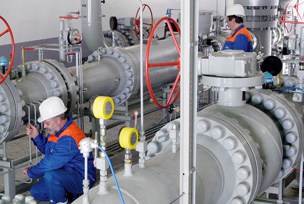
Mainova
As one of the most innovative utility companies in Germany, Mainova AG is always striving to increase the efficiency of its network operation. The implementation of mobile solutions and field service management software at its subsidiary network company, NRM Netzdienste Rhein-Main GmbH, has enabled substantial improvements in planning and job processing in the areas of electricity, gas, water, and heat.
Like all German utility companies, NRM faces increasing cost pressures associated with the incentive regulation passed by the Federal Network Agency. In order to keep the service and maintenance of its network infrastructure at a consistently high level of quality in a cost-effective way, the decision was made in 2009 to move to mobile solutions and field service management software at NRM.
 A particular challenge was to use the solution in the four sectors of electricity, gas, water and district heating alike.
A particular challenge was to use the solution in the four sectors of electricity, gas, water and district heating alike.Projects for the mobile solution, as well as for the dispatching tool, were separately tendered. It was important that it be possible to handle the entire process – from job origination to technical completion. The relevant technical back office system (here IBM Maximo) needed to be seamlessly integrated. For this purpose, the existing web services infrastructure (here SAP PI) would need to be used.
One particular challenge here was to implement the solution in the four areas of electricity, gas, water, and district heating with equivalent functionality. As a result, not only was the mobile device subject to different requirements, but this was also the case for processes on site and for dispatching work assignments.
Mainova / NRM decided to implement the field service management Suite from mobileX. The solution consists of the mobile maintenance solution mobileX-MIP for Field Service and the graphical resource planning tool mobileX-Dispatch.
Assignments in maintenance are made in a „rugged“ environment. For that reason NRM opted to use „industrial-strength“ or „ruggedised“ Psion smartphones (Ikôn). For more complex tasks (with documents or GIS maps), the technician uses a Windows tablet (manufacturer: Motion Computing). On both device types (smartphone and tablet), the standard solution mobileX-MIP for Field Service is used. Technicians use this to enter their work hours and report their job status. Here, mobileX-MIP for Field Service manages the data flow between the approx. 300 technicians on site and the back-office system Maximo.
A group of 23 dispatchers works in the main office with the standard tool “mobileX-Dispatch” for resource planning. A particular challenge for the dispatching solution is working in crews or teams: Employees are often dispatched in the morning in teams and become separated during the day, or new groups have to be formed. In these cases the employees in resource planning use the „Team planning“ function in mobileX-Dispatch.
NRM is making the move organisationally to cross-divisional planning. This means that tasks and activities from all Mainova divisions are centrally assigned to technicians in dispatching.
Summary
With the implementation of mobileX-MIP for Field Service and mobileX-Dispatch, NRM and thus Mainova AG have made great strides in cost and resource management. Job lead times have been significantly shortened using work scheduling, dispatching, and technical completion confirmation. The next step planned is to introduce the additional module “Dynamic Forms” for flexible confirmation of technical status in different system classes.

With 2012 revenues of €1.9 billion, Mainova AG is one of the 10 largest regional utility companies in Germany and the largest in Hesse. It supplies electricity, gas, heat, and water to over a million people in Hesse and neighbouring federal states.
Mainova AG generates around 40% of the electricity it sells itself – and exclusively at plants that use co-generaton. The company also invests in renewable energies such as photovoltaics, biomass power plants, wind power, and hydroelectric power plants.
